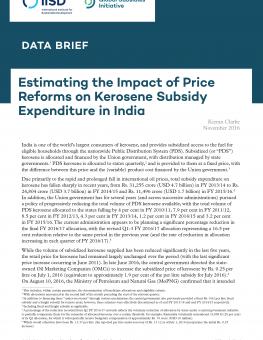
Estimating the Impact of Price Reforms on Kerosene Subsidy Expenditure in India
This data brief examines the fiscal impact of India's recently announced kerosene price reform policy.
India is one of the world's largest users of kerosene, most of which is provided at highly subsidized prices and at significant fiscal cost to poor households through the national Public Distribution System.
In late 2016, the Government of India announced that it would permit subsidized kerosene prices to rise by INR 0.25 every two weeks until at March 31, 2017. This short report examines subsidized kerosene consumption data to determine the fiscal impact of this process of price revision.
You might also be interested in
India Faces Clean Energy Challenges as Energy Demand Soars and Global Fossil Fuel Subsidies Rise
New research finds the global energy crisis and increasing energy demand have pushed India's energy subsidies to a 9-year high.
G20 energy ministers call for cooperation on nuclear energy & low-emission hydrogen
The Group of 20 energy ministers' meeting concluded in Goa on July 22, 2023, with the final summary failing to include language on the phase-down of unabated fossil fuels.
Implementing Solar Irrigation Sustainably
This guidebook provides recommendations to state policy-makers on how they can implement solar irrigation models, particularly decentralized solar plants for irrigation under the PM-KUSUM scheme, effectively and sustainably.
What the G7 Ministerial Could Have Delivered on Fossil Fuel Subsidies Reform
The G7 climate, energy, and environment ministers’ meeting in Turin fell short when it came to breaking the 15 years of gridlock on fossil fuel subsidies. Here are three ways the G7 can use their next meetings to demonstrate measurable progress.